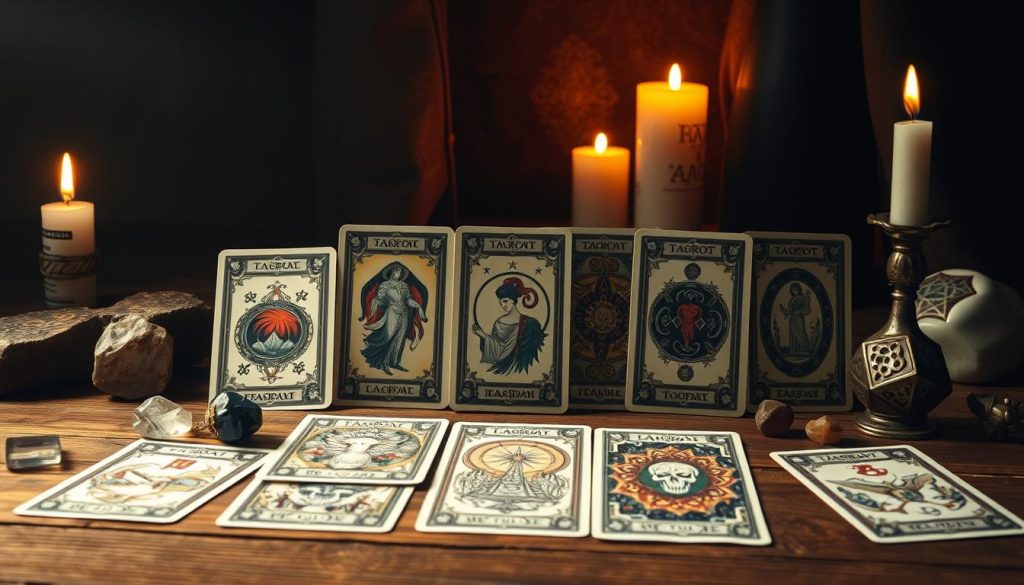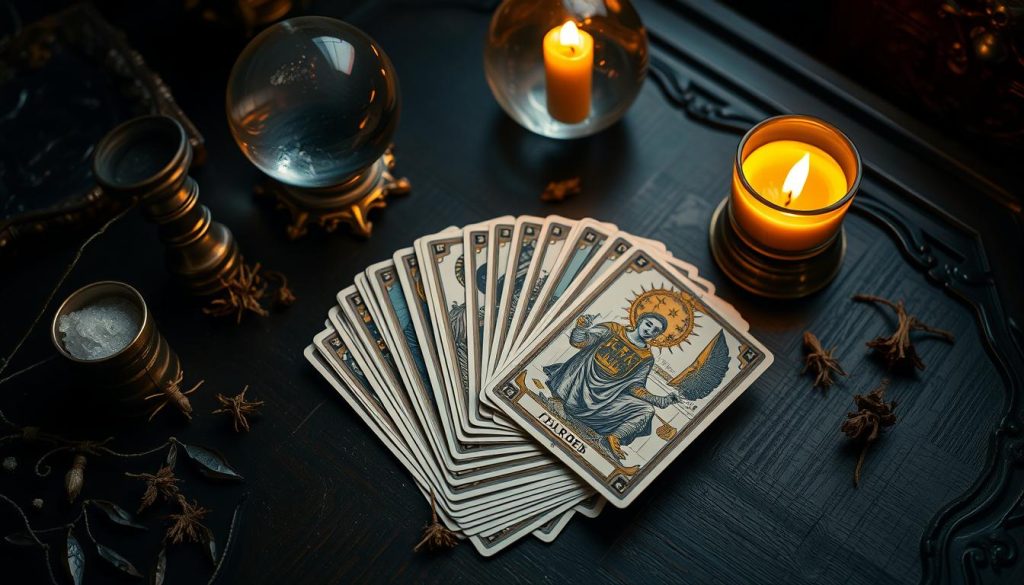Welcome. We invite you into a practical intro that blends mystery with clear steps. This is a gentle space where the deck becomes a mirror for your intuition and daily life.
We’ll show the need know basics so you can begin a steady practice. Expect short rituals, simple spreads, and tips for what to do when a brand-new deck is in your hands.
Along the way, we point to trusted creators and resources so people in the modern world never feel stuck scrolling. You’ll learn how to ask questions that invite guidance and how symbols translate into useful insight.
This first step balances wonder and usefulness. By the end, you’ll have a small, repeatable flow that lifts your intuition and fits the way you live.
Start with the right mindset: tarot as intuition, not fixed fate
First, we invite a mindset that treats the deck as a mirror, not a script. Benebell Wen frames this work as psychological: a tool that opens access to subconscious insight rather than locking in destiny.
Think of each card as a symbol-rich snapshot. The art speaks to mind and heart at once. That first, honest reaction often carries the clearest understanding you need know right now.
Brigit Esselmont reminds us the imagery is a bridge to inner power. So ask, “What energy is present, and how can I respond?” That simple shift keeps people empowered and curious.
Practice noticing breath, body cues, and quick impressions when you pull a card. Your intuition strengthens with use. Over time, recurring images help you spot patterns in the world and guide action without fear.
We reframe unsettling cards as conversations about timing and choice, not doom. Keep questions gentle, check your breath, and let images invite a clear, compassionate way forward.
Choose your first tarot deck with confidence
When you shop for a deck, let curiosity and comfort lead rather than popularity lists. This is about connection, not a checklist. Feel the artwork and notice what sparks a small, steady yes.

Listening to your intuition in the store or online
Browse in bookstores or metaphysical shops and lift a few boxes. Hold a deck, feel its weight, and peek at the backs. Let certain images make you pause.
If you shop online, make a short list of decks and watch full YouTube walkthroughs. Seeing all 78 cards helps you sense the overall vibe and style.
Why you don’t have to start with Rider-Waite
Classics teach well, but alignment beats tradition. If a Rider-Waite set clashes with your taste, pick a deck that feels like a friend.
Follow your interest — minimalist lines, ethereal art, or quirky themes all work. A deck you love will invite you to read more often, and that practice builds skill faster than any “perfect” choice.
Find your learning path: watch, read, listen, or journal
Find a study rhythm that fits your day: one lesson, one listen, one quick pull. Small, steady steps build real skill. Mix media and keep it playful.
Watch
Prefer video? Queue Kelly-Ann Maddox’s Trainee Tarot Course on YouTube. The ten-video playlist links archetypes to life and helps you pull a card alongside structured lessons.
Read
Like books? Try Bakara Wintner’s “WTF is Tarot? … & How Do I Do It?” for clear, modern card-by-card explanations you can test the same day.
Listen
Listen while you move. Lindsay Mack’s Tarot for the Wild Soul podcast ties archetypes to current themes. It’s great for absorbing layers during a commute or walk.
Journal
Write first impressions before checking meanings. Labyrinthos is a useful reference when you need clarity.
Mix and match: one video, one chapter, one episode, one spread. Keep a short list of 1–2 trusted readers or sources. This limits overwhelm and builds steady internal references over time.
Getting to know your deck the right way
Begin by looking, not labeling; let the art speak before the words arrive. We slow down and meet each image with fresh eyes. Hold a single card, notice color, movement, and where figures gaze. Jot one line of first impressions before consulting any text.

Read the little white book first. It gives quick keywords you can use while you practice. If your set includes a companion book, dive into it next. Companion guides often explain an artist’s intent and show why certain symbols appear.
For example, Patrick Valenza’s Deviant Moon companion reveals odd childhood and cemetery influences. That context deepens connection and speeds memory. If no companion exists, pick a reputable guide or bookstore reference and pair it with your notes.
Revisit a handful of cards daily. Compare your notes with the guide’s interpretation and mark repeating images—birds, water, mountains. Over time you gain real understanding. Many readers say the deck begins to speak in its own voice, and that is the clearest way into confident work.
Card meanings without overwhelm
We’ll give you a clear, gentle map so meanings feel useful, not heavy.
Start with suits as simple domains. Wands point to energy and creative will. Cups show feelings and relationships. Swords name thoughts and messages. Pentacles focus on money, work, and the tangible. These light keywords give a fast way into any spread.
Majors and single-card practice
Major Arcana cards act like chapter markers. When one appears, slow down and look for a big theme or shift. For daily fluency, pull a single card, note color, posture, and write one sentence of meaning. This tiny habit builds steady understanding without cramming.
From one card to a short story
Add a second card and ask how it changes the first. Do elements connect, clash, or complete each other? Move to three cards and tell a before/now/next sequence. Keep meanings flexible: your first line is a seed. Return to your notes each week and watch your read tarot skill grow.
Shuffling, pulling cards, and choosing spreads that fit your style
Let your hands find a rhythm — shuffling is where the body meets intuition. Choose a method that respects your deck and your comfort. Try a casino riffle for a crisp snap, a gentle overhand for softness, or lay the deck out and hover until one card calls.
Different draw ways matter. Notice jumpers, cut and choose, or pull from a fan when your fingertips tingle. Each way gives a slightly different signal and helps your confidence grow.
Beginner-friendly layouts
Start with a daily draw for focus. Move to two cards — energy and advice — when you want clarity without noise. Try a Four-Card Check-In: one Major as signifier, then three Minors for physical, mental/emotional, and spiritual points.
When to expand and make your own
Give yourself time. Repeat small spreads and keep notes on which layout clarifies fastest. When you feel steady, test classic spreads, then sketch a custom layout that mirrors your questions and life style. Your process can change with time — let it.
Ask better questions to get better readings
We craft questions that let the deck show choices, not verdicts. A small shift in phrasing opens room for nuance, timing, and clear options.
Open-ended prompts that invite guidance over yes/no
Trade “Will I…?” for “What do I need know about this situation?” This invites patterns, obstacles, and timing instead of a binary outcome.
Ask about obstacles, strengths, and mindful actions. Notice how a single card can name an energy, not a single answer.
Career, money, and life examples that keep you empowered
Try: “What strengths can I lean on in this transition?” or “What should I be mindful of in this workplace dynamic?”
For money ask: “What energy supports steadier resources now?” For life path choices try: “What’s being invited if I say yes?” and “What stabilizes me if I wait?”
If a 5 of Wands appears, ask how friction is showing up and which response moves things forward with less noise. Close every reading by choosing one tiny action.
Build a shortlist of go-to prompts so people you read for — and your future self — leave with clarity and practical agency. We call that the need know and the way forward.
Build a daily practice and a tarot journal that actually helps
A steady, short practice moves this work from curiosity into clarity. Keep sessions small. This helps your mind slip into a receptive state and makes habit easy.

Daily draw routine, timing, and weekly review
Anchor a morning or evening draw. Same time each day builds rhythm. Try a single pull or a Four-Card Check-In for quick focus.
Log each pull: the cards, question, first impressions, and one small action. Tiny things compound into meaningful change.
At week end, flip through entries. Circle repeats and note patterns. This quick review turns readings into clear signals.
Track repeats, themes, and interpretation growth
Watch for stalker cards. A repeating Hanged Man, for example, often points to a lesson still integrating. Noting it helps you adjust with less friction.
Add follow-ups a few days later: what unfolded, what surprised you. Track situational things like sleep or a friend interaction to connect real life with what appears.
Keep the journal simple — pen, phone, or app. Over years this short habit becomes a map of your journey and steady growth.
Tarot for Beginners: How to Start Reading Cards the Right Way
Watching live pulls and honest replays helps you feel the rhythm of real readings. Seeing technique in action makes pacing, phrasing, and transitions click faster than solo study.
Receive a few sessions and notice how a reader refines a question before any card is shown. That moment often shapes the whole message.
Tune in once a week to free offerings like Bakara Wintner’s Sunday Reading on Instagram or vetted YouTube demos. Watch how pros summarize and close. See how they turn symbol language into practical next steps you can actually work with.
When you return to your practice, borrow one or two techniques and test them. Log results in your journal. Small experiments teach more than long theory.
Finally, find a tiny study group or online forum. Community keeps us honest and inspired. Give yourself permission to start reading for others in short, gentle increments — one card, one focus, one clear action at a time.
Ready to start? Shuffle, pull, and trust your journey
Ready for a gentle nudge? Tonight, shuffle your first tarot deck, pull a single tarot card, and write one clear line of meaning.
Keep it small: one pull, one note, one tiny action. When you feel steady, add a second draw or a short spread like the Four-Card Check-In.
Rotate decks over months. Different artwork unlocks new layers, especially in suits like wands where energy shifts between decks.
Use readings for real situations—work, money, relationships—and log what you tried. A light app or a simple journal timestamp helps track themes over years.
Expect a bit of wobble at first. Breathe, ask one clear question, pull, and trust your mind-body cues. Keep showing up with curiosity.
Our invite: visit www.mysticbolt.com for free tools that support focus, ritual timing, and reflection. One small step tonight makes this journey your own.
New to Tarot or leveling up? Begin with our Tarot guides and spreads: https://mysticbolt.com/category/tarot/ . Next, build focus with Self-Hypnosis & Mind Training: https://mysticbolt.com/category/self-hypnosis-mind-training/ . Align your visuals and intentions in Manifestation & Visualization: https://mysticbolt.com/category/manifestation-visualization/ . Decode timing and signs with Numerology & Angel Numbers: https://mysticbolt.com/category/numerology-angel-numbers/ . Try quick interactive tools in Mystical Fun & Free Apps: https://mysticbolt.com/category/mystical-fun-free-apps/ .
